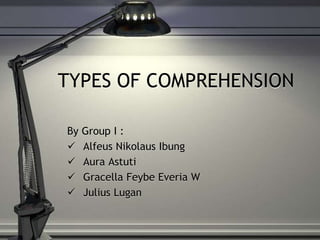Reading - Types of Comprehension
There are six main types of reading comprehension questions: 1. Literal questions test straightforward understanding and can be answered directly from the text. 2. Reorganization questions require combining details from different parts of the text. 3. Inference questions involve drawing conclusions not explicitly stated in the text. 4. Prediction questions ask readers to anticipate what may occur based on text details and their own knowledge. 5. Evaluation questions require making a judgment about some aspect of the text. 6. Personal response questions have no single right answer but must relate to the reader's understanding and opinion of the text. Being aware of these question types can help ensure students practice important comprehension skills.

Recomendados
Mais conteúdo relacionado
Mais procurados
Mais procurados (20)
Destaque
Destaque (17)
Semelhante a Reading - Types of Comprehension
Semelhante a Reading - Types of Comprehension (20)
Último
Último (20)
Reading - Types of Comprehension
- 1. TYPES OF COMPREHENSION By Group I : Alfeus Nikolaus Ibung Aura Astuti Gracella Feybe Everia W Julius Lugan
- 2. Types of Question There have been a number of attempts to classify reading comprehension questions according to their content. The classification that follows is not particularly original. It is intended to be useful as a form or checklist; by classifying your questions against it you can find out whether you are omitting any important kinds of question and thus failing to give practice in some important skills.
- 3. Divided into six types • Literal • Reorganization • Inference • Prediction • Evaluation • Personal Response
- 4. Literal Types Refers to an understanding of the straightforward meaning of the text, such as facts, vocabulary, dates, times, and locations. Question of literal comprehension can be answered directly and explicitly from the text.
- 5. When did Rahman’s wife have an accident ? (look at Appendix A text 2) Answer :
- 6. Reorganization Types Is based on literal understanding of the text; students must use information from various parts of the text and combine them for additional understanding.
- 7. For Example : We might read at the beginning of a text that a woman named Maria Kim was born in 1945 and then later at the end of text that She died in 1990. In order to answer this question, How old was Maria Kim when she died?, the student has to put together two pieces of information that are from different parts of the text.
- 8. How many children had Rahman ? (Look at Appendix A text 2) Answer :
- 9. Inference Types Making inferences involves more than literal understanding. Students may initially have a difficult time answering inference questions because the answers are based on material that is in the text but not explicitly stated. An inference involves students combining their literal understanding of the text with their own knowledge and intuitions.
- 10. For Example : Miss White has recess duty. Jacob finds a frog, picks it up, and runs over to show it to Miss White. Miss White screams, jumps, and runs as fast as she can into the school. • What can you infer from this passage? • What are the “clues” in this passage?
- 11. Which people were in Rahman’s house when the accident happened ? (Look at Appendix A text 2 ) Answer :
- 12. Prediction Types Involves students using both their understanding of the passage and their own knowledge of the topic and related matters in a systematic fashion to determine what might happen next or after a story end.
- 13. For Example Student could read the first two paragraphs of a passage and then be asked a question about what might happen next. They can determine the answer by reading the reminder of the text.
- 14. Evaluation Types Requires the learner to give a global or comprehensive judgment about some aspect of the text.
- 15. For Example: A comprehension question that requires the reader to give an evaluation of this article is : How will the information in this article be useful to you ? In order to answer this type of question, student must use both a literal understanding of the text and their knowledge of the text’s topic and related issues.
- 16. Personal Response Types Requires readers to respond with their feelings for the text and the subject. The answers are not found in the text; they come strictly from the readers. While no personal responses are incorrect, they cannot be un founded; they must relate to the content of the text and reflect a literal understanding of the material.
- 17. For Example An example of a comprehension question that requires a personal response is : What do you like or dislike about this article? Like an evaluation question, students have to use both their literal understanding and their own knowledge to respond.
- 18. CONCLUSION
- 19. T H A N K Y O U
